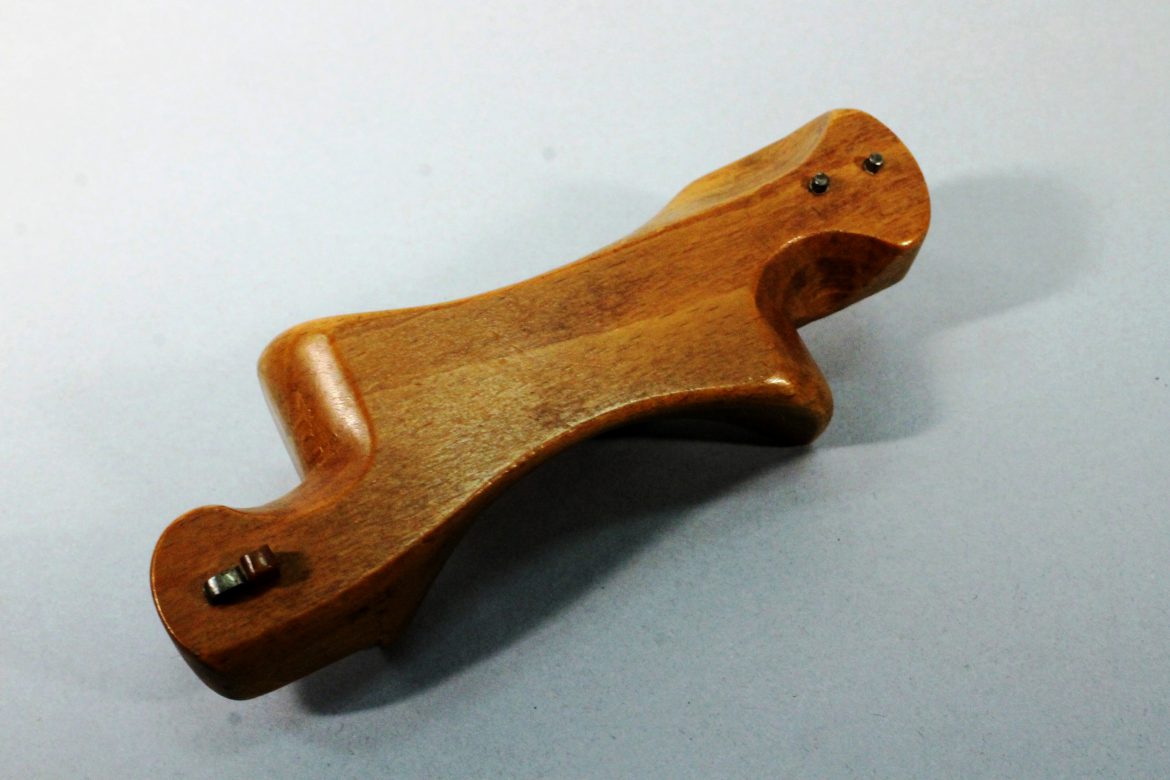
Sash Marking Gauge, Church Family, Mount Lebanon, NY, Ca. 1830, Shaker Museum | Mount Lebanon, 1950.1170.1.
Though a tool’s primary attribute is its function, sometimes the maker or user of a tool will take the time, usually in an expression of pride, to decorate it with paint or carving. The object presented here was left undecorated by its maker but has a memorable sculptural quality that is closely related to how it was used. The tool is a gauge made to mark out […]

Sash Marking Gauge, Church Family, Mount Lebanon, NY, Ca. 1830, Shaker Museum | Mount Lebanon, 1950.1170.1.
Though a tool’s primary attribute is its function, sometimes the maker or user of a tool will take the time, usually in an expression of pride, to decorate it with paint or carving. The object presented here was left undecorated by its maker but has a memorable sculptural quality that is closely related to how it was used. The tool is a gauge made to mark out the position of mortises used in joining pieces of wooden window sash. Window sash – the movable part of a window – is composed of a frame with a top and bottom rail and two side pieces called stiles. Thinner horizontal and vertical pieces called muntins or mullions crisscross the frame to support the glazing when it is composed of more than a single piece of glass. The muntins are attached to the frame with mortise and tenon joints – the joint where a square or rectangular peg (tenon) is inserted into a square or rectangular hole (mortise). The rails and stiles of the frame are connected in the same manner but with larger mortises and tenons. When faced with making hundreds if not thousands of these joints (Shaker buildings have a lot of window) it must have been thought prudent to make a special tool for the job.
This sash gauge can make two different sets of marks on a piece of wood. One end of the gauge, fitted with two thin sharp blades set three-eighths of an inch apart, marked the mortises and tenons that joined the rails and stiles; the other end of the gauge, with two blades set one-eighth of an inch apart, marked the mortises and tenons that join the muntins to the frame. Marking joinery with a sharp knife blade is generally more accurate than using a pencil. This gauge is ergonomic, having specific places carefully carved to accommodate the thumb and forefinger when using either end.

Sash Marking Gauge (detail of D. R. stamp), Church Family, Mount Lebanon, NY, Ca. 1830, Shaker Museum | Mount Lebanon, 1950.1170.1.
Brother David Rowley, who was a cabinetmaker at the North Family for twenty years, made the gauge. He moved to the Church Family the summer of 1830 where he continued making furniture and window sashes until his death in 1855. His initials, “D. R.,” are stamped on the tool as they are on several woodworking planes, a saw, another adjustable marking gauge, and a set of saw horses in the Museum’s collection. Brother David was born in Sharon, Connecticut in 1779, and chose a career as a cabinetmaker in part due to his small stature (David stood 4’ 10 3/8” inches high) and his feeling that farming, his preferred occupation, would be “too heavy for [his] physical endurance.” He moved from Connecticut to New Lebanon, New York, where his uncle lived, married, and established his cabinetmaking business. He soon learned about the Shakers and being a person with an unsettled spiritual life, became more and more interested in them, until he “saw that they were both by precept & example, the true followers of Christ.” Within a few years he joined the Shakers.

“Shakers, their mode of Worship.” (Hand-Colored Lithograph), D. W. Kellogg, Hartford, Connecticut,Ca. 1835, Shaker Museum | Mount Lebanon: 1958.10574.1
The artist of a well known illustration of the Shakers worshiping in the Meetinghouse at Mount Lebanon, NY, may have captured an image of Brother David. His stature apparently caught the attention of the artist who included a diminutive Shaker brother in his illustration. As a member of the North Family at Mount Lebanon, Brother David would have participated in the public meeting, the only meeting that the artist would have been allowed to attend.
While there are no known pieces of Shaker furniture that can be attributed absolutely to Brother David, he most assuredly was responsible for much of the early furniture that can be traced to the North Family. His tools help preserve his legacy.